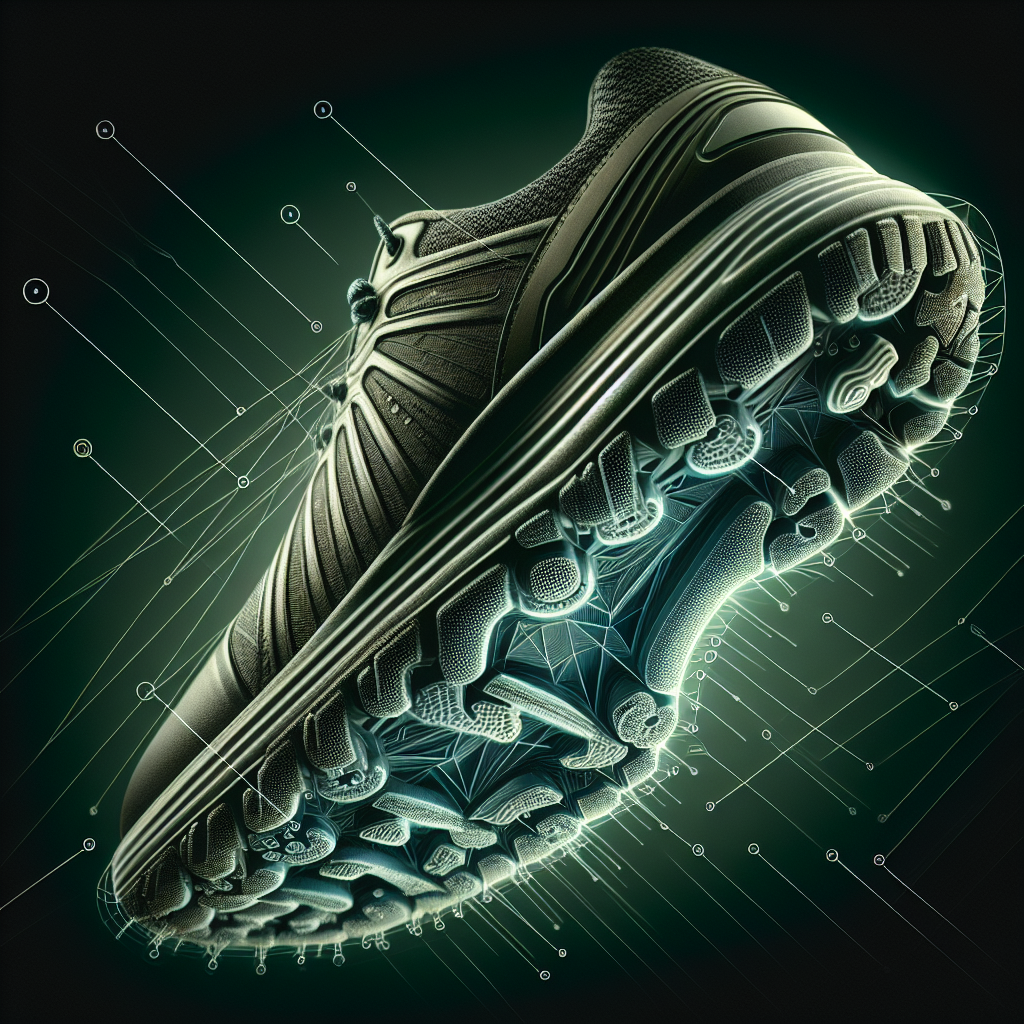
Picture yourself on a bright sunny day, standing on the lush green fairway, ready to swing your golf club with precision. But have you ever stopped to think about the role your golf shoes play in your performance? Traction, my friend, is the secret ingredient that can make or break your game on the golf course. From keeping you steady during a swing to allowing you to confidently stride across various terrains, the importance of traction in golf shoes cannot be overstated. In this article, we will delve into the significance of traction and how it can enhance your overall performance, enabling you to conquer any golf course with ease. So, let’s lace up our shoes, dig in, and unlock the true potential of our golf game.
Understanding the Importance of Traction in Golf Shoes
When it comes to playing golf, having the right equipment and gear is crucial for ensuring optimal performance. One aspect that often goes overlooked but plays a vital role in a golfer’s game is traction. Traction refers to the grip or friction between the golf shoe and the ground. It is a key element that can significantly impact a golfer’s performance on the course.
What is Traction?
Traction, in the context of golf shoes, is the ability of the shoe’s sole to provide grip and stability on various surfaces. It allows golfers to maintain balance and control during their swings, preventing slips and slides. Having the right amount of traction can make a significant difference in a golfer’s overall game.
There are different types of traction commonly found in golf shoes. Traditional spiked shoes feature cleats or spikes strategically placed on the outsole to increase traction. These spikes penetrate the ground, providing stability and preventing the golfer from sliding during their swing. Modern golf shoes now offer spikeless designs, featuring intricate patterns on the outsole that mimic the gripping properties of traditional spikes. These patterns, often made of rubber or other materials, increase surface area contact, enhancing traction without the need for traditional spikes.
The Significance of Traction in Golf Shoes
Traction is a crucial element of golf footwear. It directly affects a golfer’s ability to maintain balance, generate power, and execute precise shots. Without proper traction, a golfer may experience instability, leading to inconsistent swings and compromised performance.
Golfers need good traction for several reasons. First and foremost, it allows them to maintain their balance throughout the swing. By having a firm grip on the ground, golfers can generate power and maximize the transfer of energy from their body to the club. Without traction, a golfer’s swing may lack power and stability, resulting in less distance and control over their shots.
Additionally, good traction improves a golfer’s ability to navigate different terrains. Golf courses can vary widely, from wet and slippery conditions to hilly or sloping terrain. Having proper traction on different surfaces ensures that golfers can maintain stability and control, regardless of the course conditions.
How Traction Affects Performance
The connection between traction and performance in golf is undeniable. Traction plays a fundamental role in several aspects directly impacting a golfer’s performance.
Balance is crucial in golf, and traction plays a significant role in maintaining it. During the swing, a golfer must maintain stability and stay rooted to the ground, which requires a secure grip. With proper traction, a golfer can achieve the necessary stability and execute consistent, balanced swings.
Traction also plays a key role in power generation. As a golfer swings the club, the feet are a crucial part of transferring energy from the body to the clubhead. With optimal traction, a golfer can effectively push off the ground, utilizing the ground reaction force to generate power and speed in their swing.
In addition to power generation, traction directly impacts swing speed. A golfer with good traction can confidently execute their swing, knowing that their feet are securely grounded. This confidence allows for a faster, more aggressive swing, resulting in increased swing speed and greater distance.
Furthermore, traction greatly influences accuracy and precision in golf shots. When a golfer has a stable base and a firm grip on the ground, they have better control over their body movements throughout the swing. This control translates into more accurate and precise shots, enabling golfers to hit their intended targets consistently.
The Role of Traction in Stability
Stability is of utmost importance in golf, as it directly affects a golfer’s ability to execute consistent shots. Traction plays a critical role in enhancing stability on the golf course.
Stability in golf refers to the ability to maintain a balanced and steady position throughout the swing. By having good traction, golfers can prevent unnecessary movements or shifts in weight during the swing, ensuring a consistent and stable swing motion.
With proper traction, golfers can maintain a solid foundation throughout their swing, eliminating any potential loss of balance. This stability allows them to focus on their swing mechanics, rather than worrying about keeping their footing.
The Impact of Traction on Swing Mechanics
Traction has a direct impact on a golfer’s swing mechanics. It influences various aspects of the swing, including body rotation, weight distribution, and footwork.
Traction affects the golfer’s body rotation during the swing. With sufficient traction, a golfer can rotate their body smoothly, generating torque and power. The grip between the golf shoes and the ground facilitates this rotation, allowing the golfer to fully utilize their body’s potential for generating swing speed and distance.
Proper traction also plays a role in weight distribution during the swing. As a golfer shifts their weight from the backswing to the downswing, having a stable footing enables them to transfer their weight efficiently. This weight transfer is essential for generating power and maintaining balance throughout the swing.
Footwork is another crucial aspect impacted by traction. The grip between the golf shoes and the ground provides stability and prevents unnecessary slipping or sliding during foot movement. This ensures precise footwork and allows golfers to maintain balance and control, resulting in consistent and accurate swings.
Traction and Control on Different Terrains
Golf courses are diverse in terms of terrain and conditions, presenting unique challenges to players. Traction plays a crucial role in providing control and stability across different types of terrain.
In wet and slippery conditions, proper traction becomes even more important. The grip between the golf shoe and the ground ensures that a golfer can maintain stability and prevent slips, regardless of the moisture on the course. Good traction in these conditions allows golfers to confidently execute their swings without worrying about losing balance or control.
Additionally, traction varies between grass and synthetic surfaces. Natural grass can be unpredictable, with varying levels of softness and firmness. Proper traction on grass ensures that golfers can maintain stability and execute consistent swings, regardless of the grass’s condition.
Synthetic surfaces, such as artificial turf or mats, provide a different type of challenge. They often have different gripping properties than natural grass, requiring golf shoes with appropriate traction to prevent slips or slides.
Hilly or sloping terrain poses its own set of challenges, with potential uneven surfaces and changes in elevation. Having adequate traction allows golfers to navigate these terrains with confidence, maintaining balance and control throughout their swings.
The Role of Traction in Preventing Slips and Injuries
Slips and falls on the golf course not only impact a golfer’s performance but also pose a risk of injury. Proper traction in golf shoes plays a crucial role in minimizing the risk of slips and preventing common golf-related injuries.
Preventing slips and falls on the golf course is essential for maintaining a golfer’s performance and confidence. The grip provided by the golf shoes’ traction ensures that golfers can walk and move safely on various surfaces. It reduces the likelihood of sliding or losing balance, even in challenging conditions.
In addition to preventing slips, traction also minimizes the risk of common golf injuries. When a golfer has good traction, they can maintain stability and control throughout their swings, reducing the risk of sudden movements or imbalances that could result in strains, sprains, or other injuries.
The Influence of Traction on Weight Transfer
Weight transfer is a critical element in generating power and distance in a golf swing. Proper traction in golf shoes plays a significant role in facilitating efficient weight transfer during the swing.
Weight transfer refers to the shifting of the golfer’s body weight from the backswing to the downswing. This transfer of weight allows golfers to generate power and achieve maximum clubhead speed.
With optimal traction, golfers can effectively push off the ground, utilizing the ground reaction force to facilitate weight transfer. The grip between the golf shoes and the ground ensures that the transfer of weight is smooth and efficient, maximizing the golfer’s swing power.
Factors that Contribute to Enhanced Traction
Several factors contribute to enhanced traction in golf shoes. Understanding these factors can help golfers make informed decisions when selecting their footwear.
The materials used in golf shoe outsoles play a significant role in traction. Different rubber compounds or other materials can provide varying levels of grip and durability. Golfers should consider the type of surface they typically play on and choose shoes with outsoles designed to excel in those conditions.
Spikes and cleats also contribute to traction in golf shoes. Traditional spiked shoes feature cleats or spikes on the outsole, penetrating the ground and providing excellent grip. The arrangement and configuration of these spikes can impact traction on different surfaces. Spikeless golf shoes, on the other hand, utilize patterns on the outsole to enhance traction without the need for traditional spikes. The design and material of these patterns can further enhance surface area contact and grip.
Maintenance and cleaning also play a role in optimal traction. Over time, dirt, grass, and debris can accumulate on the outsole, reducing grip and traction. Regularly cleaning the golf shoes and ensuring that the outsoles are clear of any obstructions can help maintain optimal traction.
In conclusion, traction plays a crucial role in a golfer’s game, directly impacting performance, stability, swing mechanics, and control on different terrains. It prevents slips and injuries while facilitating efficient weight transfer and increasing a golfer’s confidence. Factors like materials, spikes, and maintenance contribute to enhanced traction in golf shoes. By understanding the importance of traction and selecting the right footwear, golfers can improve their game and enjoy a more stable and successful golfing experience.





